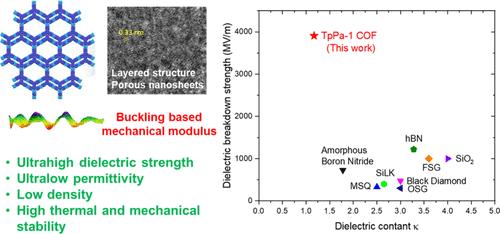Two-Dimensional Covalent Organic Framework Films for High Dielectric Strength Electrically and Thermo-Mechanically Stable Low Permittivity Dielectrics
IF 16
1区 材料科学
Q1 CHEMISTRY, MULTIDISCIPLINARY
引用次数: 0
Abstract
There is an urgent need to develop advanced dielectric materials with low permittivities (κ < 1.6) to address performance-limiting challenges for conventional and artificial intelligence (AI) microprocessors with miniaturized feature sizes, namely, delay in processing speeds, electronic crosstalk, high power consumption, and charge buildup. Known low-κ materials show poor dielectric strength and thermo-mechanical properties, rendering them unsuitable for next-generation electronic devices. Here, we demonstrate that the two-dimensional (2D) covalent organic frameworks (COF) films synthesized by the liquid–liquid interfacial reaction show very low permittivities (κ ≈ 1.17 at 100 kHz), ultrahigh dielectric strengths of ≈ 3908 MV/m at room temperature (≈2100 MV/m at 300 °C), low density of ≈1.1 g/cm3, and a high Young’s modulus of ≈3.4 GPa. These properties are enabled by the highly crystalline and tightly packed nanoporous nanosheets of 2D COFs arranged in periodic structures in 2D COF films and surpass the requirements for next-generation electronic devices.

二维共价有机框架膜用于高介电强度电和热机械稳定的低介电常数介电材料
目前迫切需要开发具有低介电常数(κ < 1.6)的先进介电材料,以解决传统和人工智能(AI)微处理器具有小型化特征尺寸的性能限制挑战,即处理速度延迟、电子串扰、高功耗和电荷积累。已知的低κ材料表现出较差的介电强度和热机械性能,使其不适合用于下一代电子器件。在此,我们证明了通过液-液界面反应合成的二维(2D)共价有机框架(COF)薄膜具有非常低的介电常数(在100 kHz时κ≈1.17),室温时的介电强度为≈3908 MV/m(在300℃时≈2100 MV/m),低密度为≈1.1 g/cm3,高杨氏模量为≈3.4 GPa。这些特性是由高度结晶和紧密堆积的二维碳纳米管纳米片在二维碳纳米管薄膜中以周期性结构排列而实现的,并且超过了下一代电子器件的要求。
本文章由计算机程序翻译,如有差异,请以英文原文为准。
求助全文
约1分钟内获得全文
求助全文
来源期刊

ACS Nano
工程技术-材料科学:综合
CiteScore
26.00
自引率
4.10%
发文量
1627
审稿时长
1.7 months
期刊介绍:
ACS Nano, published monthly, serves as an international forum for comprehensive articles on nanoscience and nanotechnology research at the intersections of chemistry, biology, materials science, physics, and engineering. The journal fosters communication among scientists in these communities, facilitating collaboration, new research opportunities, and advancements through discoveries. ACS Nano covers synthesis, assembly, characterization, theory, and simulation of nanostructures, nanobiotechnology, nanofabrication, methods and tools for nanoscience and nanotechnology, and self- and directed-assembly. Alongside original research articles, it offers thorough reviews, perspectives on cutting-edge research, and discussions envisioning the future of nanoscience and nanotechnology.
 求助内容:
求助内容: 应助结果提醒方式:
应助结果提醒方式:


